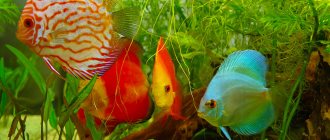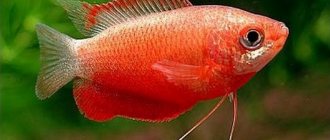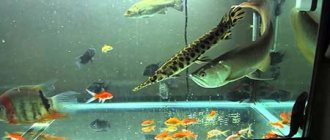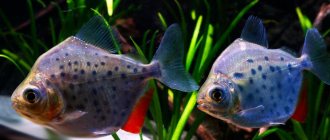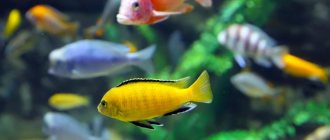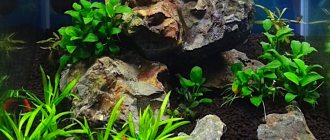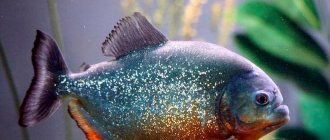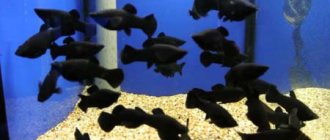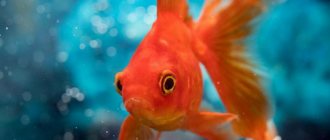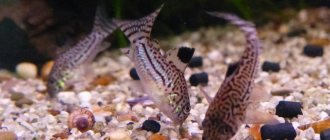The African continent is home to a huge number of fish species representing the large and diverse family of Cichlids (or Cichlids). A significant part of them are endemic (that is, they are not found anywhere else in the world). The geographic centers of cichlid habitat are the Great African Lakes (Victoria, Malawi, Tanganyika), as well as many smaller bodies of water (other lakes, rivers, streams).
The Great Lakes are virtually isolated bodies of water that formed on faults in tectonic plates many millions of years ago. This explains the special composition of the water - it is consistently hard, alkaline, and sometimes brackish.
The hydrobionts inhabiting the lakes have been isolated from other bodies of water throughout the history of their development, and therefore have formed thousands of unique species, up to 95% of which are found only in narrow habitats.
Huge lakes are conventionally divided into biotopes (surf zone, rocky or sandy bottom, deep layers of water), and each niche is literally teeming with life.
These aquarium fish, so desirable and valuable all over the world, are mostly commercial fish for the natives of Africa. Over the past couple of decades, African authorities have limited fishing (especially for export) due to declining populations and the threat of extinction of many species. Fortunately, all cichlids reproduce safely in captivity.
Which cichlids are considered dwarf?
To simplify the classification, all cichlids are conditionally divided into groups - large, medium and small. Among the latter, a separate category has emerged in recent years - dwarf cichlids. Photos and descriptions of these beautiful fish will pleasantly surprise any connoisseur. However, some experts may be interested: on what basis are some cichlids classified as dwarf and others not?
First of all, as the name implies, you should pay attention to the size. Males in most cichlid species are larger than females. Therefore, it is customary to focus on them. If their maximum length is no more than 12 centimeters, then this variety is usually classified as dwarf.
However, although size is one of the most important factors, it is not the only one. It is also customary to monitor the behavior of the fish. The dwarf group includes only species in which the majority of representatives are calm and peaceful. That is, a mandatory requirement is high compatibility - so that the fish do not pose a danger to neighbors in a small aquarium, such as themselves or smaller ones.
Main types
Malawi is particularly densely populated with endemic cichlid species (approximately 800 species are known, but only a third have been described). Cichlids inhabiting different biotopes are conventionally divided into groups that are characterized by similar behavioral and nutritional characteristics.
Malawian cichlids are easy to keep in aquariums. Many similar species tend to interbreed, so strictly separate species aquariums are needed to obtain pure lines. These “Africans” are kept in families, which include one male and from 2 to 6 females.
Below are Malawian cichlids and their photos with descriptions.
Chromis the Handsome
Known for its aggression and flamboyance. Body color is bright red with greenish specks. Grows 12-15cm. It is a predator, so it destroys all the little things in the aquarium.
Princess of Burundi
Schooling fish, breaking into pairs only during the spawning period. They love a lot of hiding places, but spend most of their time freely swimming around the aquarium. Quite peaceful to any neighbors. They feed on algae, plankton and insects. Princesses grow up to 12-15 cm, have a delicate light color, and a beautiful lyre-shaped tail fin. For a group of fish, a volume of 150 liters is required.
Queen of Taganka
A beautiful fish of impressive size (up to 40cm). Has an attractive fatty growth on the forehead (in males it is much larger). Several fairly similar morphs live in different parts of Tanganyika. The schooling predatory fish gets along well with many species and is practically not aggressive. Frontosas live in families of 8-12 individuals; each male requires 3 females.
Pelvicachromis pulcher
Among aquarists, the fish is better known as the parrot. Popular for their small size and variegated colors. They are micropredators. The main body color is gray-brown, with bright spots on the head, belly and fins. In nature, males reach 9-10 cm, females 7, but in an aquarium they are much smaller.
Haplochrimis cornflower
Males have a bright and even blue color (hence the name) with 9-12 dark stripes across the body; an orange border runs along the bottom of the anal fin. Females are silvery and begin to turn blue with age. Size up to 16cm.
Haplochrimis venustus
Large fish – up to 25cm. The color is golden, with brownish spots (but with age they become less noticeable), the fins are bluish, the head is bright blue. Females and young are light brown and spotted. They are distinguished by an interesting method of hunting: the cichlid pretends to be dead, and then quickly attacks a fish that is ungainly nearby.
Melanochromis auratus
Or a golden parrot. The males of this species are extremely vicious towards each other. The fish have a long body and a large rounded head. Males are colored brown, females are golden. They grow up to 9-11cm. For a harem, a volume of 200 liters is sufficient.
Pseudotropheus lombardo
The color of the male and female is sharply different, as if they belong to different species: the first are golden, the second are blue, and both have noticeably pronounced transverse stripes. The maximum size is 10-16cm.
Melanochromis johana
Sexual demorphism is also pronounced: males are blue with bright blue longitudinal stripes, females are yellow, plain. Size 10cm.
Pseudotropheus demasoni
Bright and popular look. It has a torpedo-shaped body and a wonderful color: alternating transverse stripes of almost black and blue colors.
Pseudotropheus zebra
It has several morphs: yellow, red, blue. The fish got its name because of the 7-8 pronounced stripes on its body.
Fenestratus
Grows in an aquarium up to 14cm. The color is very attractive: blue head and fins, the main background of the body is yellow-orange.
Tyrannochromis
a small genus belongs to the Cichlid family, consisting of only 4 species. The maximum size is 30cm. All representatives have a very predatory appearance, a long body, a pointed muzzle and a large mouth. They prefer a solitary lifestyle. They feed on any smaller fish.
Lionhead cichlid
A large fatty bump on the male's forehead gives the fish some resemblance to the king of beasts. Bottom dwellers most often move along the bottom in jerks, resting on it with their fins. Small (up to 11-13cm), peaceful and accommodating. They form monogamous couples.
Stellate tropheus
It gained incredible popularity for its unusual color: the juveniles have a black body with bright white spots, changing their color to a tricolor as they grow - a blue head, a dark body and a wide yellow stripe across. The shape is characteristic of all tropheus: an elongated low body, a rounded head. The size in the aquarium is up to 12cm. Predominantly herbivorous species. Tropheus live in families, a male and 5-6 females per 200 liters of volume. For two or three males, the volume of the aquarium and the number of shelters increase noticeably.
Where do they live?
Before talking about the types of dwarf cichlids, it is worth briefly mentioning their habitat.
It's quite big. On sale you can see fish native to Asia, Africa and South America. Of course, this provides a huge variety: if you describe the species of dwarf cichlids, you would have to write an entire book. This can safely include about fifty families of aquarium fish, each of which includes several species.
Most of them live in rivers with weak currents or small lakes. Small sizes leave a certain imprint on the behavior of fish. They live in flocks and prefer secluded corners - overgrown with thick algae or near snags. Which is understandable - in the wild, many predators do not refuse to feast on fish 5-10 centimeters in size. Of course, this must be taken into account when designing an aquarium if you want the inhabitants to feel as comfortable as possible, live long and produce healthy offspring.
Cichlids of South America
If we start talking about the varieties of dwarf cichlids imported from South America, then first of all it is worth noting that they are the most numerous. The size range is also quite large. The smallest is Apistogrammoides - in this species, males rarely have a body length of more than four centimeters. But there are also quite large representatives of cichlids. For example, in the families Apistogramma, Guianacara and Tahuantinsuyoa, males grow up to 12 centimeters. By the way, the dwarf cockatoo cichlid, a fairly popular aquarium fish that enjoys considerable popularity among connoisseurs, belongs to the Apistogram family.
Guests from Africa
African cichlids are slightly larger than their South American relatives. The average size here ranges from 8 to 12 centimeters.
Representatives of the Nanochromis family are considered the smallest. It includes eight species of fish, but even the largest males have a body length of no more than seven centimeters. But the complete opposite of them are Etia and Pelmatochromis. Some of their males reach 14 centimeters, which is why, according to the existing system, they should not be included in the number of dwarf cichlids at all. However, in all other characteristics they are quite consistent - peaceful, calm, males strongly resemble females. Because of this, experts decided to make a small exception for them by enrolling them in the appropriate group.
Description of the cichlid family
The cichlidae family includes about 1.5 thousand species of freshwater fish from the order Perciformes. Of these, more than 1,200 live in Africa. The rest inhabit bodies of water in the Americas, Asia, and Madagascar.
Representatives of the family are incredibly diverse in size, behavior and appearance. Features characteristic of all adult specimens of cichlids are one long dorsal fin, a special jaw structure, a double lateral line, and a large head. The classic body shape is elongated, fairly tall, and laterally flattened to varying degrees. But there are many exceptions.
All cichlids are spawning fish, distinguished by obvious intelligence, territorial and capricious, amazingly caring for eggs and offspring (until the young themselves disperse from their parents in search of an independent life).
Most are not suitable for a community aquarium due to territoriality and aggression.
The exact number of described species is unknown, since the anatomical differences in many of them are negligible. This makes the work of biologists difficult. New species are still being discovered to this day, and scientists believe that this is far from the limit.
For more information about what cichlids look like, look at the photos:
Mbuna group
The group lives in rocks, its representatives are predominantly herbivores. The lion's share of the diet is algal fouling along with the plankton inhabiting them. Therefore, in an aquarium with mbuna, you should abandon living plants (because they will be eaten), or plant hard-leaved species (Cryptocoryne, Anubias).
Representatives of the Mbuna group are extremely uncooperative neighbors, especially during the spawning period. They are kept in species aquariums, or proportionate peaceful fish are added to them. The main thing is that the color of the neighbors is noticeably different.
Cichlids of Lake Malawi, Mbuna group, catalog with photos:
Utaka group
Representatives of the duck live in shallow waters or in underwater reefs. They feed on a variety of living organisms, including relatives that can fit into their mouth. In a common aquarium, all the neighbors that the ducks can swallow will also gradually be eaten.
Traitor group
A small group is deep-sea, rather large predators, popular objects for industrial and sport fishing, but quite rare in aquariums (adult fish require over a ton of volume).
Character and habits
“Africans” have won the love of aquarists around the world with their interesting behavior, brightness, variety of species, and relative unpretentiousness. Fish have a unique social behavior and a strict school hierarchy. It is incredibly interesting to watch the process of courtship and reproduction. Many females incubate the eggs (and then continue to carefully carry the fry) in their mouths.
African cichlids are among the most aggressive and territorial. But, as a rule, only males of the same species, or males of different species with similar coloring, are intolerant of each other. Some overcrowding in the aquarium can dispel aggression, but this tactic will require sufficient experience from the aquarist to maintain normal parameters. Cichlids can only live in clean water.
All cichlids are rather timid and cautious creatures that prefer to spend a lot of time in shelters. But over time, smart fish begin to recognize and distinguish their owner from other people, and show special trust in him.
The most popular in the aquarium hobby are Malawi cichlids (the main species, their descriptions and photos will be discussed below).
Fish from Asia
The Asian family is the smallest. Science knows only three species of dwarf cichlids, whose homeland is Asia. Because of this, some experts prefer not to even separate them into a separate group. However, it will still be useful to learn about them.
We list all three species: Etroplus Cuvier, Iranocichla hormuzensis Coad and Etroplus maculatus. They have been known for a long time. For example, Etroplus maculatus was discovered at the end of the eighteenth century! It is not surprising that they became popular in many countries a long time ago. They were actively bred in our country - even before the 1917 revolution!
All of them cannot boast of large sizes - the largest males are about 8 centimeters long. And in other respects they are quite consistent with the features that unite dwarf cichlids. Therefore, despite their small numbers, they can be confidently called standard representatives of the family.
Cichlid Compatibility
Cichlids rarely get along with other fish. Only the most peaceful ones. Representatives of their groups can live among themselves in a spacious aquarium (for example, only Tanganyika cichlids). It is less common to combine “Africa” and “America”. This is usually not possible due to different requirements for detention conditions. Be prepared for wars between and within species. Cichlids build a hierarchy, choose and protect shelters, and almost always have claims against all their neighbors - be it a sister cichlid or a pterygoplicht catfish. But this quarrelsomeness and restlessness is all the charm of the cichlid!
Choosing the right water
In general, aquarium dwarf cichlids are not too demanding of water. Throughout their history, they lived in relatively soft fresh water, often not very clean. Therefore, there will be no special problems here.
Soft water with a slight deviation towards acidity is considered optimal - pH 6.5. But they are quite picky about temperature. Still, in their natural environment, fish live in the tropics and even the equator. Therefore, it is very important to ensure that the temperature does not fall below +25 degrees, but in general it is better that it is consistently one to three degrees higher. In general, fish can survive at temperatures around +23, but in this case they will eat worse and get sick more often. Growth slows down, the color scheme becomes scarcer - the fish will no longer be so bright and attractive. They either do not go to spawn at all, or do it quite rarely. Therefore, if the apartment is not warm enough, purchasing a heater will be very useful.
But the most dangerous are temperature changes. Even a fluctuation of just two or three degrees can cause serious illness and even death of fish. Therefore, it is advisable to install the aquarium at a distance from windows and heating radiators. And also protect it from drafts. Only in this case can the aquarist be sure that his pets will be healthy and will delight the owner not only with a riot of colors, but also with healthy offspring.
Cichlid diseases
These fish have good immunity, so they rarely get sick. They are susceptible to common fungal infections (ichthyophthyriosis, etc.), the manifestations of which are white spots and tubercles on the body, plaque, peeling scales, frayed fins. The fish become lethargic, hide, and healthy representatives (if there are any left, since usually the entire aquarium is infected) try to kill the sick fish. It can be treated with conventional means in accordance with the diagnosis. Typically these are drops that are added to the water with the lights off and minimal filtration.
How to set up an aquarium?
The next stage is the proper design of the aquarium. On the one hand, it provides cichlids with maximum comfort. On the other hand, it will highlight their external attractiveness.
Let's start with the ground. In general, there are no preferences here - you can choose either coarse sand or small pebbles. Cichlids do not have the habit of digging in the ground, so here it is more likely to adapt to the algae that you have chosen for the aquarium. The only thing to consider is its color. The darker the fish, the lighter the soil should be. However, every novice aquarist already knows this rule, so there is no point in focusing on it.
There will also be no problems when choosing algae. Any plants that can grow densely enough to provide the fish with a cozy and safe haven will work well. As mentioned above, in the wild, dwarf cichlids often hide from predators in aquatic plants. Of course, there is no such threat in an aquarium, but still the fish feel more comfortable in the thickets. However, this does not mean that you need to plant the entire available area with algae. You can either densely plant one corner (about one third or a quarter of the aquarium's area), leaving the rest of the area free, or plant the plants against the back wall, leaving plenty of open space in front. After all, cichlids, although calm, are quite active fish, and it is advisable to give them enough space for play and active swimming.
It would be useful to use various elements for decoration - large stones (the main thing is that they do not have sharp edges that could injure the fish) or specially treated driftwood. Thanks to them, the aquarium will acquire special elegance and elegance, and the cichlids will feel at home. But it is not advisable to use sinks. Over time, they increase the hardness of the water, and cichlids prefer soft water.
Diseases - prevention and treatment
Cichlids are quite strong fish. All diseases are usually associated with improper keeping of cichlids. For them, the cleanliness of the aquarium, its volume, compliance with temperature conditions and nutritious food are very important.
It is also important to observe the quarantine regime for new plants and soil, new inhabitants of the aquarium and live food.
Types of diseases
The most common diseases of cichlids:
- hexamitosis is an enlargement of the pores on the head and along the lateral line; the fish stop eating and become weaker; they can be cured with metronidazole, but the disease cannot be neglected;
- ichthyophthiriasis or semolina - white plaque on the skin; treated with quinine hydrochloride;
- American bloat - the body of the fish inflates, the eyes become bulging; fish stop eating and become lethargic; treated with antibiotics;
- saprolegniosis – growths appear on the body; treated with phenoxyethanol.
Suitable nutrition
But with nutrition, it’s not easy to give unambiguous advice. If only because among dwarf cichlids there are both species that prefer plant food and predatory ones. Therefore, the diet should be prepared accordingly.
However, for everyone, live food will be the best choice - bloodworms, tubifex, brine shrimp, and for the smallest species, cyclops is also suitable. Thanks to this diet, the inhabitants of the aquarium will receive all the necessary substances for a comfortable life and reproduction. But when choosing herbivorous fish, it would be useful to add some greens to the diet - they need more vitamins, which are difficult to obtain from animal food.
Of course, in extreme cases, fish can live on dry food - even on daphnia and gammarus. But a long absence of live food worsens the well-being of cichlids. Therefore, if it is not possible to get bloodworms and tubifex, try to at least pick up special granules - they are better balanced and contain almost all the necessary vitamins and microelements.
Features of keeping at home
More than 600 species of cichlids are popular among aquarists, although even the largest and most aggressive representatives find their fans.
Aquarium requirements and external conditions
Cichlids require large volumes, and the most important thing is a large bottom area and space. It is necessary to conditionally divide the aquarium into parts with decorative items (driftwood, stones). But especially large species break decorations and can even break glass, so heavy objects should be secured carefully.
With rare exceptions, cichlids desperately dig the soil, which is why plants can only be planted with a strong root system, and then covered with stones (or in pots).
Cichlids will live long and please their owners only in clean water, so aeration and more powerful filtration will not hurt.
Nutrition
A balanced diet is the key to health, active behavior and an attractive appearance for “Africans”. Dry food should only be used from trusted manufacturers.
But they should be the basis of the diet; animal protein and natural herbal supplements are very necessary for fish:
- fresh greens (lettuce, dandelion, nettle, duckweed, etc.), thoroughly washed and scalded with boiling water;
- vegetables (cucumber, zucchini, bell pepper, pumpkin, etc.) – preferably lightly boiled;
- live food (tubifex, bloodworms) in limited quantities;
- fish fillet, squid, shrimp;
- a small amount of meat (lean varieties, beef heart), but this is not necessary (in nature it is rarely included in the diet of fish).
Why proper nutrition is so important: the intestinal structure of herbivores and carnivores is different. Predatory fish have a short digestive tract, and heavy protein foods do not stay in the body for a long time. Herbivores have a fairly long intestine, and animal food takes a long time to come out, so it can cause poisoning and bloating.
The proportions depend on the individual needs of the species. For example, the share of plant nutrition for cyphotilapia will be about 10%, for melanochromis - 80%. But cyphotelapians need large amounts of high-quality protein. Melanochromis also need it, but in a very small amount.
Diseases, their treatment and prevention
Most diseases of these fish begin with inappropriate or poor living conditions. African cichlids are quite tenacious and disease resistant. Most people tolerate medications well. But, like most hydrobionts, they are prone to infection by parasites, bacteria, fungi and other diseases.
For prevention, it is important to strictly follow simple rules:
- promptly treat injuries and their consequences;
- when purchasing new residents for a community aquarium, it is important to keep them in quarantine for a couple of weeks in a separate container (infection can enter the home pond with plants, poorly treated live food, or unboiled soil);
- do not allow an increase in the concentration of harmful substances in the water, which means making timely changes (25-30% of the volume per week);
- good aeration and filtration, regular bottom siphoning are required;
- proper and balanced nutrition, weekly fasting days (healthy fish should always be a little hungry);
- a quiet place for the aquarium to avoid constant stress for pets;
- maintaining optimal water parameters for each specific species (hardness, acidity, temperature, etc.), for this, only fish with similar requirements should be kept in one aquarium, and tests should always be ready to check.
We must not forget the two golden rules for aquarists - do not overfeed and do not allow overpopulation.
Optimal care
Cichlids are relatively unpretentious in care. It is enough to clean regularly - ideally half an hour after each feeding. However, if there are bottom fish in the aquarium that will collect the remains of the cichlids’ meal, you can reduce the number of cleanings to one per week.
In any case, you need to change some of the water weekly. Not too much - no more than one fifth of the total volume of the aquarium. Of course, the water must be at a suitable temperature and not contain chlorine. Therefore, it is advisable to settle the water - taking cold water from the tap, let it stand for a day or two in an enamel bucket. Then the temperature will rise to room temperature, and the chlorine will gradually evaporate.
There will probably be no other hassle during maintenance. Despite their sonorous and incomprehensible names, aquarium cichlids require quite little attention.
We select neighbors
However, few aquarists, having got cichlids and populated the aquarium with them, decide to leave them in splendid isolation. Most people will be interested in having neighbors move in with them. But here you need to be careful so that the neighborhood does not cause trouble to either side or the other.
First of all, we should recommend catfish. Cichlids rarely sink to the bottom. Therefore, the bottom area will still be empty. Several large catfish will perfectly smooth out the void, and at the same time eat the remaining food that has settled to the bottom. Thanks to this, cleaning will have to be done much less often.
Many cyprinids can be a good choice. The main thing is to make sure that they are not too aggressive. For example, a flock of barbs will quickly make life completely unbearable for the unfortunate cichlids. Choose medium-sized, calm, peace-loving fish. You can also recommend not too large characoid fish, as well as melanotenia. Representatives of most other families will not make good neighbors for cichlids.
